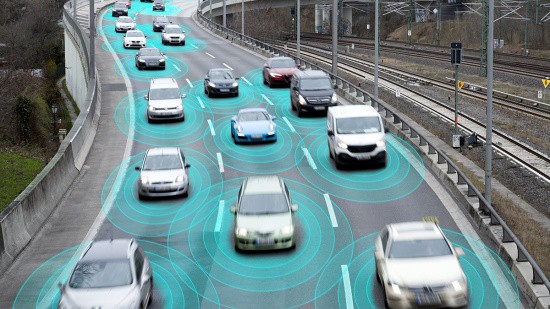Autonomous vehicle software provider Oxbotica has partnered with Cisco to allow autonomous vehicles (AVs) to connect to OpenRoaming-enabled hotspots. Communications are secured using Cisco’s cloud enterprise network security platform, Umbrella, with data being uploaded to Oxbotica’s cloud.
The two companies are involved in the Next Generation Connected Vehicles Co-Innovation trial , which demonstrates how AV users will be able to access, customise and integrate the leading mobile autonomy IP into their own products. The platform to be tested is designed to be fully-scalable, capable of being deployed across various fleet networks no matter the size or location, while delivering cost-effective and secure data offload.
With this new partnership, Oxbotica hopes to unlock the potential of fully-connected autonomous vehicle fleets, enabling the seamless and secure sharing of high-volume data while on the move.
“As part of our Universal Autonomy vision, our pioneering software already reduces the amount of data sharing that is required, allowing vehicles to operate wherever they are, with or without network connection,” said Ozgur Tohumcu, CEO at Oxbotica.
“In fact, our software has been designed to operate not dependent on any infrastructure, so it can understand the vehicle’s environment in infinite detail. However, we fully recognise that in an autonomous world, fleets will need to upload and download vast amounts of data and the partnership with Cisco offers us the chance to solve one of the greatest data challenges of the future, already today,” he added.
OpenRoaming: No passwords required
Initiated by Cisco, OpenRoaming is a federation of providers that deploys a new wireless connection technology that allow mobile devices, including connected vehicles, to connect to trusted Wi-Fi networks automatically without typing usernames and passwords. Instead, these devices use embedded credentials issued by OEMs and AV software companies, such as Oxbotica.
OpenRoaming is particularly suited for connected vehicles, with opportunities for Wi-Fi hotspots to be deployed in locations such as gas stations, EV charging locations, parking structures and vehicle service centres.
“For industrial applications where devices, such as autonomous vehicles rather than people, are moving through areas that are covered by Wi-Fi, this technology is designed to enable that simple, automatic connection that users experience when using mobile networks. OpenRoaming opens up the possibility of a cost-effective alternative for transporting high-volume data to and from the vehicle, autonomously,” Matt MacPherson, Wireless CTO at Cisco, said.
 Massive amounts of data
Massive amounts of data
AVs make 150 independent vehicle detections every second and generate up to 80GB of data per driven-hour from sensors such as LiDAR, cameras and RADAR as well as Advanced Driver Assistance Systems (ADAS) logs. This constant activity means amassing 1.2TB of data in a 16-hour day – the equivalent of over 500 HD movies or over 200,000 songs – much of which is gathered when the vehicle returns to base.
By 2024, over 70 million new connected vehicles will enter the market every year, with each required to upload and download 8.3GB of data per day, including streamed infotainment, HD navigation, vehicle telemetry and ADAS settings – as well as safety critical information like severe weather updates or passenger ill health. By comparison, the average smartphone will contribute just a fifth of this daily volume.
Stretched across an autonomous fleet, which could include hundreds or even thousands of vehicles in a city or region, this would produce an abundance of data beyond that which could be shared efficiently and cost-effectively using existing 4G, or emerging 5G, networks.
Oxbotica has already started work on addressing this challenge with on-road trials taking place in Stratford, East London last September.
How OpenRoaming will work AVs
Combined with Wi-Fi 6 and 5G, OpenRoaming creates the potential for superfast and seamless connectivity. Cisco’s Wi-Fi 6 Access Points offers faster speeds, improved capacity, and lower latency. While Wi-Fi 6 is perfect for indoor arenas, 5G is better suited for outdoor areas—this means users will enjoy connectivity wherever they are.
“While some data is required while the AV is in motion, most data can be gathered when the AV is stationary,” said Joel Obstfeld, the Distinguished Engineer at Cisco who’s led the collaboration with Oxbotica’s engineers.
He added: “AVs, and in the near future, Connected Cars, are going to need more locations where they can transfer their high-value data. Parking garages, electric vehicle charging points, gas station forecourt, and vehicle servicing centres are just a few of the locations where OpenRoaming and Wi-Fi 6 could be deployed."
According to Cisco, OpenRoaming isn’t just for AVs, it’s game-changing for users in dense areas like airports, retail stores, arenas, and more.
The connectivity tech allows people to join wireless networks across enterprise, consumer, and public markets. OpenRoaming connects identity providers, service providers, and enterprises to share the needed credentials across networks. And good news for AV passengers too —Wi-Fi can be used with a vehicle’s cellular wide-area connection to provide local connectivity to Wi-Fi enabled devices.



